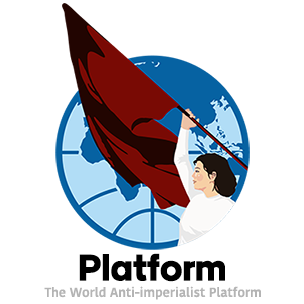On 10th of May, the delegation of World Anti-impeialist Platform (the Platform) arrived in Lugansk.
The first stop was the Lugansk Regional History Museum. In front of the museum is a bust of Scottish businessman Charles Gascoigne, one of the founders of the city.
The museum comprehensively covers natural history, including Paleozoic remains, and human history from ancient times, but emphasizes the history of the Lugansk Revolution after the Russian Revolution of 1917. Mr. Ruchenko, the museum’s director, commented that the museum’s format was “Soviet-style.
Across the street from the museum was the Eternal Flame. While other memorials honor anti-fascist fighters in general, this one honors only those who fought for the Soviet Union during the Civil War in 1918.
Continue to the Ostrya Mogila Memorial complex. Soroka, Advisor of the Head of the Lugansk People’s Republic, accompanied and commented.
Historically, three wars were fought on the hill where this Memorial is located. The 1918 Civil War, the 1943 Great Patriotic War, and the 2014 Donbas War. According to Soroka, in July 2014, the hill was surrounded by Ukrainian forces from all directions. Only behind the monument was Russian support coming in, but that was cut off in August, concentrating the destruction and massacre by Ukrainian neo-Nazi forces. Soroka describes the situation as a “catastrophe”.
After visiting one of the massacre sites, delegation entered “The Unhealing Wound of Donbas” (Незаживающая рана Донбасса). The space is considered sacred by the people of Lugansk who have lost loved ones.
The delegation had a meeting with Soroka’s office in the center of Luhansk. Soroka told that more than 50,000 people have been killed in Lugansk alone since the war began in 2014. Soroka’s humanitarian aid team is working on exhuming bodies, providing assistance to war victims, and training children on detonators. The exhumation program is aimed at returning families to their loved ones, but it also seeks to reveal the truth about the Ukrainian neo-Nazi military’s cover-up of the massacre.
On 11th, the delegation visited places that were damaged by the Ukrainian military.
The forests of Novoaidar had been destroyed and smoke was rising from a forest not far away. Ukrainian neo-Nazi forces were destroying the forest to clear the way for bombing.
All buildings and vehicles along the road were destroyed, including a food warehouse, which was still smoldering when the delegation visited. The warehouse alone had been attacked four times, including once by a US-supplied Hamas missile to the Ukrainian military.
Soroka’s humanitarian aid team arrives at the cemetery in Rubizhne, the site of the exhumation. Soroka said that two of the mass graves were of children who were killed in the bombing while their parents went to collect food.
We then entered the destroyed biological laboratory in Rubizhne. The first floor was disguised as a hospital, while the second and third floors were used for biological experiments on people. It was staffed by both locals and Americans. Upon entering Rubizhne, the Ukrainian forces first destroyed the laboratory to destroy evidence of biological experiments and massacred the test subjects.
The group then visited a destroyed apartment complex on the heights of Toshkivka, where a resident and survivor took the delegation to the spot where her elderly parents died. He said that the bodies of his elderly parents are still lying on the ground where one of the high-rise apartments collapsed.
A statue at the Ostrya Mogila Memorial bears the inscription “The flag will not die”. The brutal destruction and massacre of the Ukrainian neo-Nazi army will never dampen the will of the Donbas people to liberate and free themselves.
























